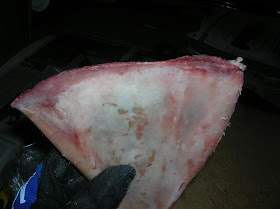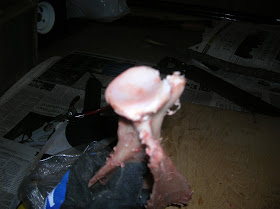I saved some deer bones from this year's deer in order to play around with and make some tools and carvings. I'm not a big fan of boiling bones to get rid of the soft tissues as this weakens the collagen bonds holding the osteon (bone) tissues together, making it brittle. I like the bones to be clean, but still maintaining the natural "give" so it doesn't shatter with use.
Obviously, get yourself a deer scapula. I like to work with partially frozen raw bones, as it helps to have the squidgy, slippery, soft tissues frozen; makes it easier to cut and scrape off with a knife. If you prefer to start with unfrozen bone, it gets a bit slimy.
Remove as much flesh as possible from the said bone, being careful not to mar the bone with knife marks. I prefer razor sharp knife held as flat to the surface of the bone as possible to flesh it properly.
Now, once you've removed enough flesh and soft tissue, look at the flat "blade" of the scapula; you should be able to discern a clear boundary between the soft cartilageneous tissue and the boney tissue - think of the border of a chicken's white cartilage 'breastbone' and the boney breastbone.
Take your knife and cut the cartilage off the shoulder blade. It should be a very easy cut.
All mammalian bones have a thin membranous covering called the periosteum; this can be easily worked off with a knife blade.
Fleshing and de-membraning completed!
Don't forget to remove as much cartilage as possible on the other end - the ball socket joint.
You'll notice that you need to change the water regularly (once a day the first week, then every few days afterwards) as more fats escapes the bone. Otherwise you might end up with a very stinky bucket of gooey stuff. Once the water stays "clear", it means there's no fats left in the bones. You can scrape off the left-over bits of soft tissue using your fingernails (or a blunt butter knife)
Air dry it for a few days. The bone will whiten up as it dries.
And voila! you have a deer scapula all ready for action! I also smoothen the blade end of the deer scapula with sandpaper so it doesn't scratch the hide it's meant to soften.
Perhaps I will later attach a wooden handle to it ... but for now the tool is fully functional as a hide staker.
Other links that might interest you:
Deer hock pouch
Deer hock pouch, iteration 2; with belt loop
How to skin deer legs for hockskins
Bark tanning hair on deer hide
Softening bark tanned hair on deer hide
How to remove the pasterns and coffin bone from a deer foot
Salt Curing deer hides for storage
Alum tawing white tail hair on neck skin
Soap/Oil tanning hoof-on, hair-on, Mule Deer hockskin
Processing green deer hide into ....
Wild Foods compilation










How well does this work for fleshing and graining a staked-out fresh hide?
ReplyDelete